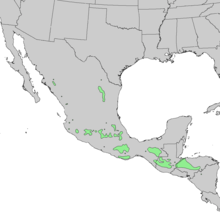Pinus pseudostrobus
| Pinus pseudostrobus | |
|---|---|
 | |
| var. apulcensis in cultivation | |
| Scientific classification | |
| Kingdom: | Plantae |
| Division: | Pinophyta |
| Class: | Pinopsida |
| Order: | Pinales |
| Family: | Pinaceae |
| Genus: | Pinus |
| Species: | P. pseudostrobus |
| Binomial name | |
| Pinus pseudostrobus Lindl. | |
 | |
| Natural range of Pinus pseudostrobus | |
Pinus pseudostrobus, known in English as the smooth-bark Mexican pine and in Spanish as chamite or pacingo, is a tree endemic to Mexico.
It is 8 to 25 m tall, dense and round top, the bark is brown and fissured and smooth when young. It grows between 1300–3250 m. From 26° to 15° north latitude, from Sinaloa, Mexico to El Salvador and Honduras. It occurs within a rainfalls regime mostly in summer. A stand of about 15 fully mature Mexican pines is in Imperial County, California, at the Palo Verde County Park, in a narrow strip of land between Hwy 78 and the Colorado River.
It has been introduced in New Zealand near sea level and has done well.
References
| Wikimedia Commons has media related to Pinus pseudostrobus. |
- Conifer Specialist Group 1998. Pinus pseudostrobus. 2006 IUCN Red List of Threatened Species. Downloaded on 10 July 2007.
This article is issued from Wikipedia - version of the 9/10/2016. The text is available under the Creative Commons Attribution/Share Alike but additional terms may apply for the media files.
